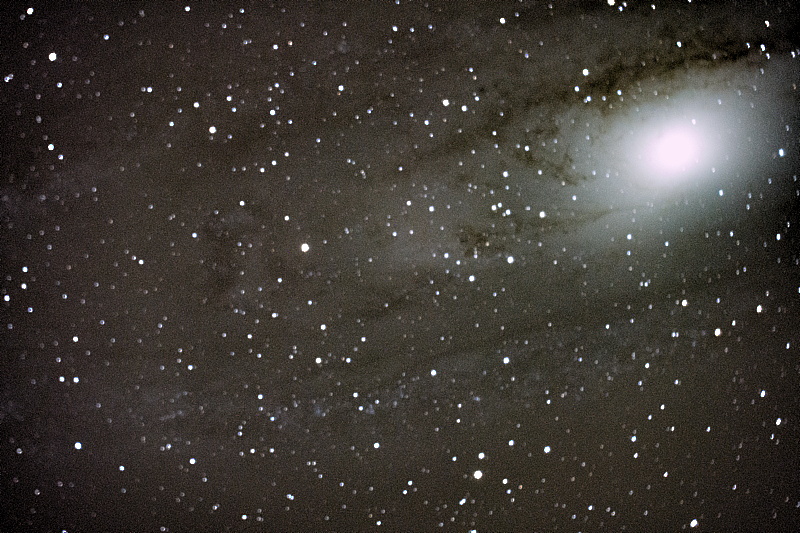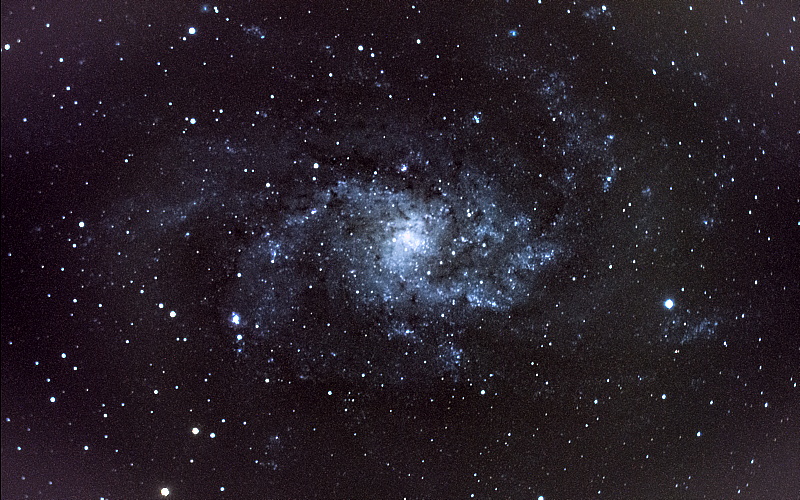iPhone ISS Pass; DSLR Andromeda, Triangulum,
& NGC1300 Galaxies; DSO Observing
Posted: 22 October 2016
|
Open: Friday, 21 October 2016, 1805 MST Temperature: 88°F |
Session: 1030 Conditions: Mostly clear, calm |
Equipment Used:
12" f/8 LX600 w/StarLock
Wireless AutoStar II handset
2" 24mm UWA eyepiece
2" 30mm eyepiece
Camera:
iPhone 6s Plus
D7200 DSLR
1810 MST: LX600 ON, StarLock OFF, High Precision OFF.
1812 MST: viewed Venus, 102X. The almost half-phase was visible. Then Saturn and its moon Titan, 102X. Then Mars, 102X. Disappointing small.
Mounted the iPhone 6s Plus with a clip-on fisheye lens on the GorillaPod and placed it on the POD Roller Desk:

Using NightCap Pro (ISS mode, ISO 5000, 250 seconds) did this image of a pass of the International Space Station (ISS):

Unfortunately, did not get the focus quite correct for the fisheye lens.
1844 MST: viewed M31 (Andromeda Galaxy) in the 12" telescope at 102X. Then began preparing to image M31 with the D7200 DSLR at prime focus + focal reducer once Astronomical Twilight ended at 1906 MST. 1900 MST: High Precision ON. Using StarLock autoguiding I took 6 5-minute, ISO 3200, White Balance 4000K, exposures of each side of the Andromeda Galaxy. The 5 minute exposures were stacked using Lynkeos for an effective exposure length of 30 minutes. Here are the results:
5 minutes, ISO 3200, WB 4000K, edited

30 minutes, ISO 3200, WB 4000K, edited

5 minutes, ISO 3200, WB 4000K, edited

30 minutes, ISO 3200, WB 4000K, edited

Then slewed to M33 (Triangulum Galaxy) and repeated the process:
5 minutes, ISO 3200, WB 4000K, edited

30 minutes, ISO 3200, WB 4000K, edited

Since I still just "play" at doing astrophotography, I think I prefer not having to do all the work for stacking images.
2115 MST: done imaging. StarLock OFF, High Precision OFF. Removed the DSLR.
Did some observing of M33, 102X. Good details visible. Switched to a 2" 30mm eyepiece (81X) and viewed M33. Lots of structure was visible.
2125 MST: decided to do the AutoStar Guided Tour "Tonight's Best" using 81X. Viewed M32 (galaxy), M31 (Andromeda Galaxy), Double Cluster (open star clusters), M34 (open cluster), M45 (Pleiades, open cluster), M38 (open cluster), M36 (open cluster), M37 (open cluster), M13 (globular cluster), M92 (globular cluster), M11 (Wild Duck Cluster, open cluster), M57 (Ring Nebula, planetary nebula), M27 (Dumbbell Nebula, planetary nebula), M15 (globular cluster), M2 (globular cluster), NGC7293 (Helix Nebula, planetary nebula), and M52 (open cluster). 2200 MST: ended tour.
Viewed M1 (Crab Nebula), 81X, but it was too low in the eastern sky for good viewing.
2210 MST: began doing sky observing using the 12x70 binoculars. Viewed M31, M32, and M110 galaxies. M31 was easily seen with my naked eyes. Also viewed M33 (Triangulum Galaxy) with the binoculars. M33 was also faintly visible to my naked eyes. It is good to live at a nice dark sky site! Viewed the Pleiades, open star clusters in Auriga, and the Double Cluster using the binoculars. All were lovely views.
2250 MST: tried to view NGC1300 (small faint galaxy), 102X, but it had not yet risen high enough in the southeast to view. 2255 MST: High Precision ON. NGC1300 was now visible. 2300 MST: mounted the DSLR at prime focus + focal reducer to image NGC1300 and began waiting for the galaxy to rise higher.
2306 MST: waning Moon rising. The Moon was not yet visible over the hill to the east but I decided to image NGC1300 before the sky began brightening. The galaxy was still too low for accurate StarLock autoguiding for more than 1 minute. Took this (cropped) 1 minute, ISO 6400, WB 4000K, prime focus + focal reducer image of NGC1300:

Plan to try for a better image on a future session.
2326 MST: ended imaging. Eastern sky brightening from rising Moon. Began closing up for the night.
|
Close: Friday, 21 October 2016, 2342 MST Temperature: 72°F |
Session Length: 5h 37m Conditions: Clear |
Comments are welcome using Email. Twitter users can use the button below to tweet this report to your followers. Thanks.
Cassiopeia Observatory Home Page
Copyright ©2016 Michael L. Weasner / mweasner@me.com
URL = http://www.weasner.com/co/Reports/2016/10/22/index.html
